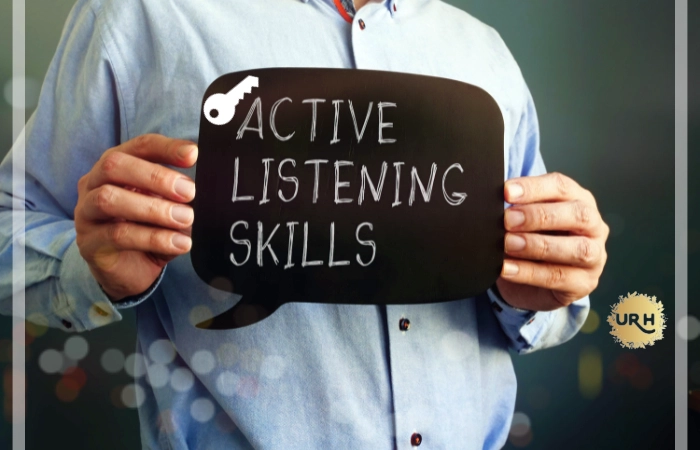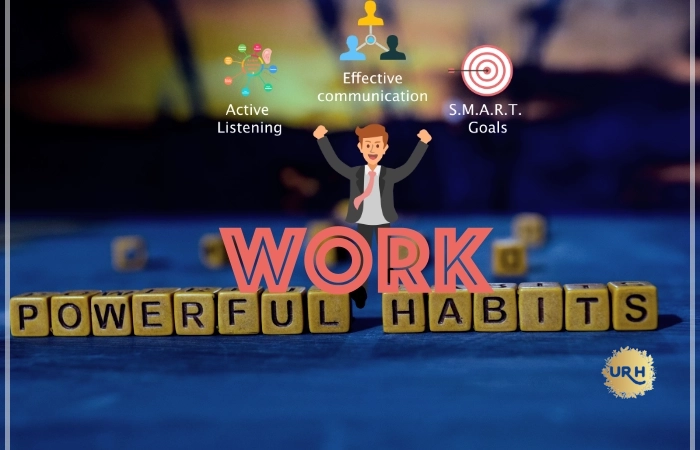Top 7 Key Active Listening Skills, Foster Conversation
If your goal is to improve your active listening skill and want to know why active listening is important and what are 7 key active listening skills? Then let me tell you most people are listening, they are actually hearing the words.
So, in this post I am going to help you understand what are 7 key active listening skills and how you can learn and use them to improve your overall communication skill.
So if you observe, during communication for many people their minds are elsewhere – either preparing what they are going to ask/say next or preparing themselves for what to say when the other person is finished speaking.
This type of inattentive listening is familiar to all of us at some point in time. Observer for next week, how many time you find people zone out when you were talking to them.
Top 7 Key Active Listening Skills
1. Attention: Being Fully Present in the Conversation
Imagine having a conversation with someone who is constantly checking their phone or looking around the room, not a great feeling, right?
When you are practicing active listening, give your undivided attention (100% attention) to the speaker, this is one of the most critical parts of active listening skills.
Put away distractions, silence notifications, and focus solely on the conversation at hand.
2. Ask Probing Questions: Encouraging Further Responses
Asking questions is not only about seeking information/clarification, it’s about showing that you are genuinely interested in what the speaker has to say and you want to genuinely understand it.
Probing questions go beyond simple yes-or-no queries; they encourage the speaker to elaborate, share more details, and express their thoughts.
These questions can start with like – “Can you tell me more about…” OR “What led you to think that..”
3. Nonverbal Communication: Observing and Noticing
Communication isn’t limited to words alone; our body language and facial expressions convey a significant part of the message.
When practicing active listening, pay attention to the speaker’s nonverbal cues. Are they excited, sad, or frustrated? Is their body language open and engaged, or closed and distant?
4. Paraphrasing: Reflecting Back on What Has Been Said
After the speaker has shared a point, take a moment to rephrase what they’ve said in your own words. This not only shows that you’re actively listening but also allows the speaker to clarify if you’ve misunderstood something.
It’s like a verbal mirror that reflects their thoughts back to them, creating a bridge of understanding between both parties.
5. Eye Contact: Showing Interest
Eyes are often referred to as the windows to the soul, and in the context of active listening, they’re the windows to your engagement.
Maintaining appropriate eye contact throughout the conversation conveys your interest and attentiveness. However, be mindful not to overdo it; staring intensely can come across as intimidating.
6. Avoid Interrupting: Listening to Understand Rather Than to Respond
We have all been guilty of interrupting someone mid-sentence to share our own thoughts or opinions, however active listening requires patience and restraint.
Instead of focusing on what you want to say next, concentrate on fully understanding the speaker’s perspective.
Let them express themselves without interruption, and save your response for when they’ve finished speaking.
7. Withholding Judgment and Advice: Being Patient and Letting the Speaker Complete
It’s human nature to jump to conclusions or offer solutions, especially when someone is sharing their challenges/thoughts.
However, true active listening involves putting aside your own judgments and resisting the urge to provide immediate advice.
Sometimes, people just need a space to express their thoughts/challenges without seeking/asking for solutions, and we need to understand this to hold our thoughts back.
When you listen to the speaker patiently and let them complete their thoughts, it creates an atmosphere of trust and empathy.
List of 7 Active Listening Skills
What are the 7 skills for active listening?
- Attention
- Ask Probing Questions
- Nonverbal Communication
- Paraphrasing
- Eye Contact
- Avoid Interrupting
- Withholding Judgment and Advice
Why Active Listening Skills Is Important:
Building Bridges in Relationships and at Work-
Imagine this scenario: you’re sharing a story with a friend, and halfway through, you notice their eyes drifting to their phone, how does that make you feel? Not too great, right?
Why Active Listening Skills Is Important – In Relationships
Picture your best friend sitting across from you, leaning in, and hanging on your every word. How awesome does that feel? It’s like emotional glue that sticks hearts together.
1. Deepens Understanding:
When you actively listen, you are not just hearing words; you are feeling the emotions of a person speaking and experiencing them.
This kind of conversation goes beyond the surface, allowing you to truly understand what the person speaking is going through (happiness, sad).
2. Fosters Empathy:
Imagine your friend sharing their excitement about a new job opportunity. Active listening lets you step into their shoes and feel their joy or apprehension. By showing that you’re truly present and listening, you build trust between you and person speaking.
3. Strengthens Trust:
Think of trust as a delicate plant. Active listening waters that plant and helps it grow strong. When you listen without judgment and genuinely hear what someone is saying, you’re nurturing the foundation of trust.
For instance, if your sibling opens up about a mistake they made, responding with, “Thank you for telling me, no problem we’ll figure it out together,” builds trust.
Why Active Listening Is Important – At Work
Now, let’s discuss how active listening works in the world of deadlines, meetings, and teamwork, yes it is your workplace.
Active listening isn’t just a soft skill, it is a skill that can boost your professional success by helping you improve your communication/interactions.
1. Enhances Collaboration:
Imagine you’re in a brainstorming session, and your coworker suggests an idea, instead of zoning out or immediately giving your opinion, active listening lets you absorb their idea, ask questions to understand it better, and build on it.
2. Improves Problem Solving:
Meetings aren’t always about high-fives and celebrations; sometimes, challenges arise. Active listening helps you get all the small things out of interaction.
As you are listening with complete involvement in the problem, ensuring you fully understand the issue before you start working on the solutions.
For example, if a project hits a roadblock, actively listening to team members’ concerns allows you to address specific issues effectively.
3. Boosts Leadership:
Leaders who actively listen are like magnets. People naturally approach the leaders who will listen to them because they know their voices will be heard. This also ensures to you that your inputs are valuable.
For instance, a manager who listens to employee feedback and implements constructive suggestions is likely to have a more engaged team.
Key Benefits of Active Listening
Now that you have understood the importance of active listening in having effective communication. Now it’s time to understand its key benefits of active listening before we go into further details.
Key Benefit 1 – Self Improvement
Speaking less in the first place will make you patient, as you learn and practice holding yourself before you speak. When you are leaving others with attention you will automatically increase your knowledge.
As you practice careful leasing you understand the concerns of others and thus you demonstrate empathy.
Key Benefit 2 – Professional Improvement
In the office environment as you practice active learning it improves the quality of conversation with others. This will have a noticeable difference in team bonding, which will allow better collaboration and improvement in productivity.
More listening will give you a chance to understand the problems in greater detail which will help you to come up with the best possible solution.
Key Benefit 3 – Social Improvement
For any relationship at genuine communication is a must, active listening helps you have genuine connections and build great relationships.
You learn to respect the speaker and hold yourself without judging keeping an open mind and empathizing gives you and the other person a chance to build a trusting relationship.
And this trust-based relationship will give you friends forever.
Active Listening Skills Examples
What does active listening look like? Here is an active listening skills examples in the form of conversation between SAM and TOM in which several different active listening techniques are used.

SAM: Hay TOM, I know this is short notice for you, My apology for dumping this on you at the last moment, I need to go, as I am picking my little champ for a match and I am already late, Amanda called me twice and she is upset.
TOM: Hi SAM, No problem! Tell me more about what happened. (open-ended question)
SAM: Well, we were arguing about who will drop little Champ for a match at the club. I’m still running out of time.
TOM: Oh that’s OK. You sound upset that you’re not able to make it on time. (reflecting what was heard)
SAM: Yes, it just makes me so angry. She assumed I would take off —I don’t have time! She didn’t understand my situation and didn’t see things from my perspective.
TOM: Oo, that needs to be looked into. How did that make you feel? (another open-ended question)
SAM: Frustrated. Angry. Maybe a bit guilty that she had all these plans, and I was the one saying, I would drop little Champ for a match at the club, Now I told her to do it without me. But that’s not right, either.
TOM: Sounds complicated. I bet you need some time to figure out how you feel about it. (withholding judgment)
SAM: Yes, I guess I do. Thanks for listening — I just needed to speak to someone
Video Credit: TED-Ed
FAQ
What is active listening?
Active listening is a communication skill that involves fully engaging with a speaker, showing genuine interest(eye contact), and understanding their message both verbally and nonverbally(nodding).
How can I improve my active listening skills?
Enhance your active listening skills by doing below
Giving your full attention
Asking open-ended questions
Observing nonverbal cues,
Paraphrasing what the speaker said
Avoiding interruptions.
Why is eye contact important in active listening?
Eye contact is important because it shows the speaker that you’re attentive and interested in what they’re saying (you are not distracted from conversion).
Should I always provide advice while actively listening?
No, it’s not necessary to offer advice during active listening. Holding off on advice can allow the speaker to express themselves more freely.
How does active listening benefit relationships?
Active listening strengthens relationships by helping better understanding(active listening), empathy, and trust(listening without judgment).
What are the 5 key active listening skills?
1. Attention
2. Ask Probing Questions
3. Nonverbal Communication
4. Paraphrasing: Reflecting Back on What Has Been Said
5. Avoid Interrupting
What are the benefits of active listening?
Key Benefit 1 – Self Improvement
Key Benefit 2 – Professional Improvement
Key Benefit 3 – Social Improvement
Conclusion
So, Active listening is more than a set of skills, it’s a mindset that you need to build and understand it from others’ perspectives.
By mastering these key active listening skills discussed above – giving undivided attention, asking probing questions, observing nonverbal cues, paraphrasing, maintaining eye contact, avoiding interruptions, and withholding judgment and advice – you can create an atmosphere of trust and empathy.
If you are also some one how is working on developing these skills, let us know your thoughts/experience in comment section below.







